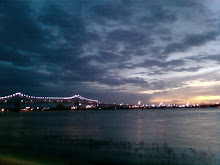
1946: We start in 1946, when Baton Rouge was a vastly smaller (and more compact) city. The developed area is dominated by the relative size of the industrial complex on the north and the university campuses (they have not grown, but the city has) on either end of the city. Development wraps around the industrial precinct in an effort to keep residences and employment centers in proximity. The developed area extends only as far inland as the current Foster Drive for the most part, except for the Old Goodwood area which comprises a low density outlier on the far eastern fringe. Virtually all development is contained within the arc of the Airline Highway bypass route.
To-day most of the residential areas shown here comprise "Mid-City" Baton Rouge.

1956: BR's immediate postwar growth trends were to the north - proximate to the industries which were the city's most important source of employment during the period. The developed area has nicely filled up the territory which was annexed into the city in 1949 with the creation of the City-Parish consolidated government. These northern suburbs were, for the most part, White working class; the south comprised the more white collar and middle class part of the city. This socioeconomic division is a long standing situation which has persisted to this day. Segregated pockets of Black residence, such as Scotlandville and Old South Baton Rouge, existed, and would come to expand over time.
On the far east end of the map, the nascent Broadmoor subdivision can be spied, comprising the first substantial urban development outside the Airline Highway bypass - a sign of things to come.

1965: Development continues to be centered in the north, but small subdivision clusters can be spied sprouting off from the Perkins Road, Jefferson Highway, and Highland Road corridors to the south, the beginnings of the current movement of scatteration to the south and east. (Then as now, these roads were not entirely suitable for long distance commuting - the growth of the south would vastly accelerate with the completion of I-10 to Gonzales.) The suburban cluster east of Airline, centered on Florida Boulevard, has grown substantially, and this area would become the locus of suburban growth through the late 1960s and into the 1970s. To the north, the small town of Baker is included as the scope of the littoral is expanded to accommodate the growing city.
At the time the Interstate system was incomplete through the area, thus this was the heyday for major arterials such as Airline Highway and Florida Boulevard. The "Florida Strip" between Foster and Airline was the city's most important suburban center during that time. However, even at this late date downtown retained some of its relative importance.

1976: In the year of America's Bicentennial, the extent of Baton Rouge's eastern growth is palpably visible. Virtually all urban expansion in the north had ended by this point and new development was largely focused on eastern EBR Parish. The 1970s were the decade which the Interstates assumed prominence in the region as transportation arterials, thus rendering less important surface highways such as Florida and Airline and laying waste to their retail offerings as shopkeepers favored locations with Interstate visibility and access.
Showing the entire parish in this scene, the map demostrates just how much empty land there is in EBR Parish, particularly in its northern extremities. At this date inter-parish suburbanization was still in the embryonic stage. Even at this late date, much of southern EBR remains rural, though change would be soon in coming.

1986: The decade of big hair and bad taste in fashion brought large scale development to southern Baton Rouge and permanently shifted scatteration trends to more of a southeastern character in the parish, reflecting the routes of the Interstates and racial/income trends. With the completion of the Interstates, cities in outlying parishes such as Denham Springs and Gonzales (not shown here) would assume prominence as satellite exurbs within the next decade. Increasing minority populations in the EBR public school system would make a Livingston or Ascension address much more desirable for White middle class families, despite the commuting distances and attendant traffic tie-ups involved. In the 1990s Zachary (the urban cluster at the far north end of the parish) would obtain its own school district and join the list of lily white exurbs. The cities of Baker and Central (incorporated 2004) have also seen fit to secede from the EBR schools.
The neighborhoods of north BR, first generation suburbs of the 1940s and 1950s, had by this time largely lost their White working class populations and had solidified into the core of Black Baton Rouge, with the area of Black residence moving like linchpins south from Scotlandville and north from the Eden Park area to subsume the district. This only continued to reinforce the long standing division of Baton Rouge between a relatively unprosperous north and a largely affluent south.
Note certain scatteration trends:
- The area south of LSU and Highland Road, with the exception of the Brightside Lane precinct and the Gardere area, is largely undeveloped and remains so as of today. The development which has taken place in this alluvial plain has largely been of the multi-family variety, accommodating university students near campus and poor Blacks in Gardere.
- Development in the south tends to avoid the creeks and waterways (and thus flood prone areas), leaving natural greenbelts around the important drainage courses. On a negative note, this development pattern precludes a great deal of connectivity between neighborhoods.



No comments:
Post a Comment